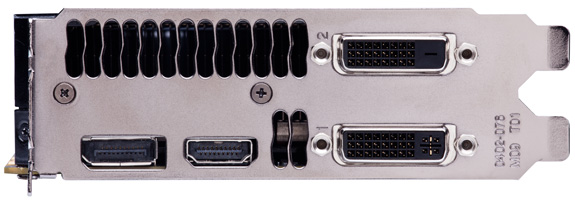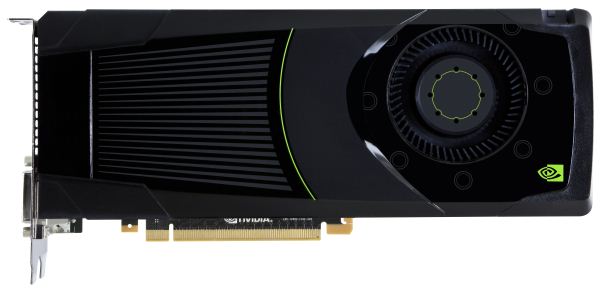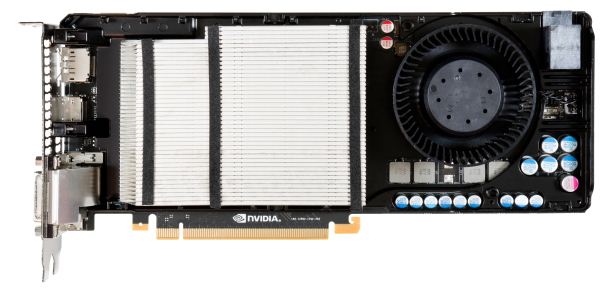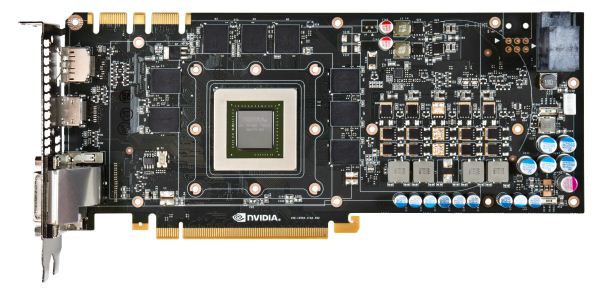NVIDIA GeForce GTX 680 Review: Retaking The Performance Crown
by Ryan Smith on March 22, 2012 9:00 AM ESTMeet the GeForce GTX 680
All things considered the design of the GeForce GTX 680 is not a radical departure from the GTX 580, but at the same time it also has some distinct differences owing to the fact that its TDP is some 50W lower than GTX 580.
Like the past GTX x80 cards, the basic design of the GTX 680 is that of a blower. A radial fan at the rear of the card sucks in air and pushes it towards the front of the card. Notably, due to a combination of card length and the fan position, the “wedge” around the fan has been done away with. NVIDIA tells us that this shouldn’t significantly impact the cooling of the card, particularly since it has a lower TDP in the first place, but when used in SLI it will remove some of the breathing room than the GTX 580 enjoyed.
Looking at the fan itself, compared to the GTX 580 the fan has been moved from the center of the card to the top of the card. This is due to NVIDIA’s port configuration, which uses a stacked DVI connector that consumes what would have normally been part of the exhaust vent on the GTX 580. We’ll get into the port configuration more in a minute, but for the moment the significance is that because the GTX 680 only has half a vent NVIDIA has moved the fan to match the vent, which is why the fan has been moved up.
On that note, the repositioning of the fan also had its own ramifications. Because the fan is now so close to the top and at the same time so close to the rear, NVIDIA went with a unique method of arranging the PCIe power sockets. Rather than having them side-by-side as we’ve seen on countless NVIDIA cards in the past, the sockets are stacked on each other in a staggered configuration. With the fan otherwise occupying the space that one of the sockets would take up, this configuration allowed NVIDIA to have two sockets without lengthening the card just to fit another socket. Overall this staggered design is not too difficult to work with, though with one socket facing the opposite way it might require some cable repositioning if you have a well maintained cable run.
Moving on, when we remove the shroud on the GTX 680 we see the fan, baseplate, and heatsink in full detail. NVIDIA is using an aluminum fin stacked heatsink, very similar to what we saw on the GTX 580. Underneath the heatsink NVIDIA is using a set of three heatpipes to transfer heat between the GPU and the heatsink. This is as opposed to the vapor chamber on the GTX 580, and while this setup doesn’t allow empirical testing, given the high efficiency of vapor chambers it’s likely that this isn’t quite as efficient, though to what degree we couldn’t say.
Finally, after removing the fan, baseplate, and heatsink, we can see the PCB in full detail. Unlike GF110 and GF114, GK104 is not capped with an IHS, allowing for the heatsink to directly come in contact with the GPU die. Meanwhile arranged around the GPU we can see the 8 2Gb GDDR5 RAM modules that give the GTX 680 its 2GB of RAM. These are Hynix R0C modules, which means they’re rated for 6GHz, the stock memory speed for the GTX 680. Overall the card measures 10” long with no overhang from the shroud, making it 0.5” shorter than the GTX 580.
Looking at the top of the card, as always we see the SLI connectors. Following in the footsteps of the GTX 580, the GTX 680 features 2 SLI connectors, allowing for up to 3-way SLI.
Meanwhile at the front of the card we see the I/O bracket. As we alluded to previously, the GTX 680 uses a stacked DVI design here; NVIDIA has done everything they can to keep the DVI ports at the very bottom of the card to avoid impeding airflow, but the upper DVI port still occupies roughly 40% of what would otherwise be the vent. Altogether the GTX 680 features 2 DL-DVI ports, a full size HDMI port, and a full size DisplayPort.

While NVIDIA has used DVI and HDMI ports for quite some time, this is the first time NVIDIA has included DIsplayPort on a reference design. Unfortunately we find that this ruffles our feathers a bit, although this isn’t strictly NVIDIA’s fault. As we’ve covered in the past, DisplayPort comes in both a full size and miniDP configuration – AMD in particular has used miniDP since the Radeon HD 6800 series in 2010. And while we’re happy to see DisplayPort finally make it into an NVIDIA reference design, the fact that it’s a full size DisplayPort is less than encouraging because at this point in time DisplayPort has largely been replaced by miniDP.
Ultimately the fault for this lies more with the VESA than NVIDIA, but it’s indicative of a larger problem in the DisplayPort community in that both full size DP and miniDP are equally valid and equally capable ports. While full size DisplayPort has the distinction of coming first, thanks in large part to Apple it has largely been displaced by miniDP as the most common variant on source devices. The problem with this is that both miniDP and DisplayPort are now in wide use; wide, redundant use.
At this point desktop computers and video cards coming with full size DisplayPorts is silly at best, and frustrating at worst. The laptop guys aren’t going to give up miniDP due to the space savings, and there’s no significantly good reason to use DisplayPort on desktops when miniDP offers the same functionality. We would rather see the PC industry standardize on miniDP across all source devices, and thereby eliminate any ambiguity with regards to what cables or adaptors are necessary. DisplayPort adoption has been slow enough – having 2 variants of the port on source devices only makes it more confusing for everyone.
Finally, while we’re on the subject of display connectivity we quickly took a look at how the idle clockspeeds of GTX 680 are impacted by the use of multiple displays. With 2 displays GTX 680 can utilize its full idle clocks, but only if both displays are connected via a TMDS type connection (DVI/HDMI) and run with identical timings. But if different timings are used or if one display is connected via DisplayPort, then the GTX 680 will shift to its low power 3D clocks. However if we expand that to 3 monitors and enable NVIDIA Surround, then the GTX 680 can operate at full idle regardless of whether DisplayPort is used or not.













404 Comments
View All Comments
CeriseCogburn - Friday, March 23, 2012 - link
That's a good combo, it's high on the charts.SpeedyGonzales - Friday, March 23, 2012 - link
AMD 7970 and Nvidia 680GTX are both good cards.Nevertheless AMD and Nvidia try to push price increases for the upper midrange class, either because of the limited supply due to the new process or because they just try.
Both cards are from a die size perspective as well as from the performance vs. last generation perspective clearly $350-399 cards.
I recommend to wait, if you are not desperate. Demonstrate, that the market does not accept price increases, specifically given, that pogress of PC graphics is massively blocked by the stupid consoles.
kmmatney - Friday, March 23, 2012 - link
To those wondering how people have enough money to buy $500 tablets ....we don't buy $500 video cards. I guess we spend moneuy on what we want - I had no trouble plucking down $500 for an iPad2, but to me onlya fool would pay $500 for a video card...evilspoons - Friday, March 23, 2012 - link
At last, the replacement for my GTX 285 has arrived.It's over twice as fast. It uses less power so I can safely continue to use the same power supply. It's quieter at idle and barely louder at full tilt. It's even smaller!
AnotherGuy - Friday, March 23, 2012 - link
"the GTX 680 is faster, cooler, and quieter than the Radeon HD 7970."From the benches I saw in ur review I only see it being a little faster on more games and slower on a couple others... Also at load nVidia gets hotter than 7970... Check the Metro bench temps!
nVidia is finally using as much power as AMD compared to what it used to use before and u gotta call it quieter and cooler?
Are u just a Fanboy or u got payed to write that down?
silverblue - Friday, March 23, 2012 - link
Shh. It does use a little less power, and AMD have historically had quicker fans, which may explain why 7970 is cooler (that, and the cooler design).AnotherGuy - Friday, March 23, 2012 - link
Do you see the the temps in Metro benchmark?http://www.anandtech.com/show/5699/nvidia-geforce-...
AMD 7970 74 Celcius, nVidia 680 GTX 78 Celsius
How is nVidia cooler ?
BoFox - Monday, March 26, 2012 - link
At idle - that's how - and also when both cards are overclocked- the 7970 obviously reaches thermal limits much quicker than GTX 680 which reaches the limit of voltage feed due to lack of power phases and 8-pin PCI-E connector for clean power.Also, when overclocking HD 7970 to say, 1150MHz, it usually requires voltage tweaking. By then, it's already consuming more power than even GTX 580!
OTOH, GTX 680 still remains rather quiet and cool-running when overclocked to the max (with dynamic voltage scaling).
BoFox - Monday, March 26, 2012 - link
Why? Isn't that a good thing? Even if just a little bit, it's still true.travbrad - Tuesday, March 27, 2012 - link
"From the benches I saw in ur review I only see it being a little faster on more games and slower on a couple others... "Look at them again. The only game where the 7970 has a performance advantage greater than 2% is Crysis Warhead, which is an old game that almost no one plays anymore.
1920x1200 percentages:
Crysis:Warhead--7970 is 12% faster
Metro2033--7970 is 2% faster
Dirt3--680 is 17% faster
Shogun2---680 is 15% faster
Batman--680 is 17% faster
Portal2--680 is 22% faster
BF3--680 is 31% faster
SC2--680 is 27% faster
Skyrim--680 is 16% faster
Civ5--7970 is 1% faster
The 680 is clearly the faster card overall, and at $50 cheaper definitely the better deal.